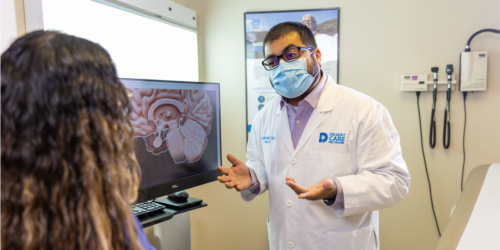Deep Brain Stimulation (DBS) Programming

Deep Brain Stimulation programming is not a cure, but instead a treatment that has been developed to vastly alleviates symptoms in Parkinson’s essential tremor, and dystonia. Not all patients are candidates for DBS therapy. Your doctor and a team of therapists help make this determination. This serious surgical procedure is:
- Minimally Invasive
- Non-Destructive
- Reversable
What is Deep Brain Stimulation Programming?
Deep brain stimulation programming, or DBS, is a surgical technique that implants electrodes into specific areas of the brain. Once implanted, the electrodes regulate abnormalities by producing electrical impulses or by communicating with certain cells or chemicals in the brain. A minuscule wire connects the electrodes in the brain to a device similar to a pacemaker. This device is surgically placed under the skin in the top region of the chest and is used to control the stimulation.
How Does DBS Help?
This established treatment for Parkinson’s disease is used to effectively reduce motor and non-motor symptoms. When patients are unable to achieve control of their symptoms with medication alone, DBS is the next step in treatment. In addition to alleviating symptoms related to Parkinson’s, it is approved to help individuals with:
- Movement Disorders
- Cervical Dystonia
- Psychiatric Disorders – OCD
- Seizures
- Essential Tremor
Research is also being conducted to assess the effectiveness of using DBS to treat other conditions including:
- Chronic Pain
- Addiction
- Dementia
- Multiple Sclerosis
- Brain Trauma
The Desert Care Network Approach to DBS
Members of the Movement Disorders Team at Desert Care Network have specialized training in Deep Brain Stimulation programming. Before proceeding with a DBS recommendation, your doctor carefully measures the potential risks and benefits of the procedure and discusses them with you. When surgery is deemed to be the best option, you are appropriately prepared for the process.
- A multidisciplinary evaluation will occur, including assessments in physical therapy, occupational therapy, speech therapy, neuropsychology, and neurosurgery.
- Imaging of your brain will be taken to assess where to implant the electrodes.
- Before the brain and chest wall portions of the surgery, you will be placed under general anesthesia.
- After your procedure it could take 4 to 6 months to achieve the appropriate setting calibration to achieve the most effective results.
Schedule Your Appointment
Feel confident that you are receiving comprehensive care combined with a compassionate approach from dedicated specialists. Get in touch with our medical staff to schedule an appointment and explore your options.
